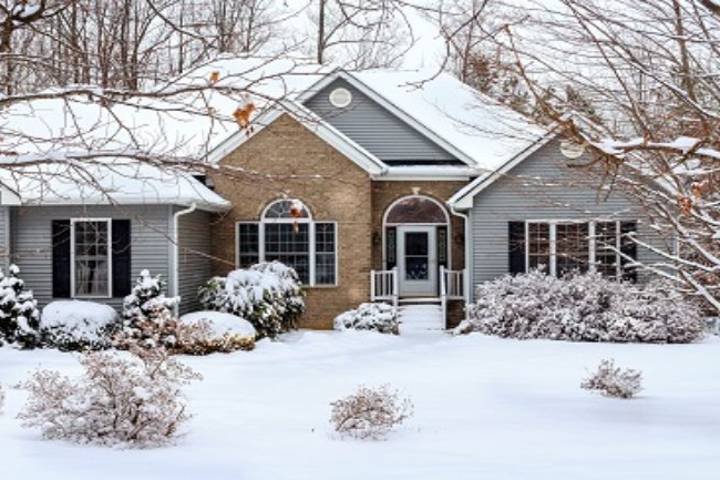
Check Out 6 Ways to Prepare Your House For Winter
The cold season is upon us and it’s time to get your house ready for the winter. You may not think there is much you can do, but you would be wrong – there are plenty of things that need to be done before the first snow fall. This post gives expert tips for helping make sure your house is ready for the cold.
Winter is a time of snow, sleet, and ice. It’s also the time when the mercury plummets to below freezing temperatures, trees lose their leaves, and Christmas carols are heard everywhere. One of the best things about winter is that it’s a time to get together with family and friends. Whether you’re celebrating Christmas, Hanukkah, Kwanzaa, or just spending time together, this is a great time of year for gatherings.
Another benefit of winter is that it’s a great time to get outdoors. No need for sunscreen or sandals, just a warm coat and some boots to keep you comfortable as you take in all that winter has to offer. Winter is also a time when people can enjoy winter sports outdoors with friends without the fear of heatstroke from long exposure to the sun’s rays, which makes it safer than summertime.
While enjoying the brisk winter air and festive atmosphere, though, you’ll want to know your home is ready. Here are 6 ways to help prepare your home for winter:
1. Tune Up Your Heating System
One of the best ways to prepare your house for winter is to tune up your heating system. This will help ensure that your furnace is running smoothly and that there are no problems with it. You can have a professional tune up your heating system or you can do it yourself.
If you’re going to do it yourself, here are some tips:
- Clean the furnace filter. This will help improve airflow and reduce heating costs.
- Check the furnace burner for obstructions and clean it if necessary.
- Check the flue pipe for obstructions and clean it if necessary.
- Inspect the heat exchanger for cracks and repair if necessary.
- Lubricate all moving parts of the furnace.
If you have a gas furnace, be sure to also check the carbon monoxide levels and adjust them if necessary.
Having a well-tuned heating system will help keep your house warm all winter long.
2. Reverse Your Ceiling Fans
Another way to prepare your home for winter is to reverse your ceiling fans. If your ceiling fans are turned to the right, change them over so they’re facing left and vice versa. In this way, you’ll be able to get a nice draft going in winter that will help warm up the room without having to use energy from the heating system. This switch only takes about five minutes and can save you money on your energy bill.
Be sure to also reverse your fans in the summer so they’ll help cool down the room.
3. Inspect and Repair the Roof and Gutters
It’s important to inspect your roof and gutters every winter to make sure there are no problems that need to be repaired. This is especially important if you have a metal roof, as the metal can expand and contract in the cold weather, which can cause roof leaks.
You should also check your gutters to make sure they’re clear of any leaves or debris that may have accumulated over the fall. If you don’t keep your gutters clean, the water will back up and could damage your home’s foundation.
While you’re at it, clean up all leaves and debris from around the outside of your property. This will help prevent any animals or children from tripping over them when they’re out playing in the yard during these colder months. It also prevents potential fires that could occur if debris builds up near a chimney or other flammable material on your property.
If you have an unfinished basement, make sure your sump pump or drainage system is working properly. You don’t want to have water in the basement when it’s cold outside, so do some regular maintenance on these systems if needed.
You can also invest in a dehumidifier for your basement, which will help remove moisture that accumulates during winter months and keep mold from growing.
4. Check the Insulation and Weatherstripping
If you live in a cold climate, it’s also important to make sure that your home is properly insulated. You can have an insulation contractor come out and do an inspection of your home to see where you may need more insulation. Adding insulation can help keep your house warm during the winter and save you money on your energy bill.
The basement can be difficult to insulate, but you should try if possible. If the basement is cold and damp during winter months, it will affect your whole house’s temperature since most of your home heat rises into the upper levels.
If you don’t want insulation added in places where it isn’t needed, then another option would be to add insulation in the places where it will do the most good. You can also use materials like bubble wrap or fiberglass batting, which are relatively inexpensive and easy to install yourself.
Another way to help keep your house warm in the winter is to caulk around windows and doors. This will help keep the cold air out and the warm air in. You can buy a caulk gun at most hardware stores and it’s a project that you can do yourself in just a few minutes.
Additional Tips
Be sure to use a high-quality caulk, like silicone caulk, which is weatherproof and will last for many years. Make sure the surfaces are clean and dry before you start caulking, and use a putty knife to smooth out the caulk once it’s in place.
Caulking around windows and doors is also a good idea because it can help prevent drafts from coming into your house.
It’s important to check the weatherstripping on exterior doors as well, since this will affect how warm or cold your home gets during winter months. If you have an older home with worn out weatherstripping, then now is the time to replace it.
You can buy weatherstripping at most hardware stores and it’s a very easy do-it-yourself project. All you need is a screwdriver and about 30 minutes of your time.
Be sure to also check the batteries in your smoke detectors and carbon monoxide detectors during winter months. These batteries should be changed at least once a year and it’s an important safety step to take.
5. Don’t Prune Trees or Shrubs Until Late Winter
It’s important not to prune trees or shrubs until late winter, as they need the cold weather to stay healthy. Pruning them too early can damage them and make them susceptible to disease. Pruning in the late fall or early winter also could result in sharp thorns, leaves and branches during the winter months that can puncture roofs or injure people or animals outside.
The best time for pruning is early spring after the plant has awakened from dormancy. This is when most flowers and fruit trees should be pruned.
If you have to trim trees or shrubs during winter, be sure to use a sharp pair of pruning shears and make clean cuts. This will help prevent any disease from entering the plant’s tissue.
When you’re done pruning, be sure to dispose of the clippings properly by putting them in a sealed bag and throwing them away in the trash. Do not compost them, as this could spread disease to your plants.
Now is also a good time to fertilize your trees and shrubs, as they will need the extra nutrients to stay healthy during winter. You can use a slow-release fertilizer or organic mulch, which will help keep the soil moisture levels constant.
It’s also a good idea to spread organic mulch around your trees and shrubs since it will help keep weeds from growing and the soil moist at the same time. Organic mulch is made up of materials like coconut husks, wood chips and pine needles and can be purchased in bags at most hardware stores.
6. Inspect Your Chimney
Inspect your chimney and make sure it is in good working order. A reputable chimney company will be able to inspect your chimney and identify any problems that may need immediate attention, such as a buildup of creosote or a cracked liner. If you don’t hire a professional, inspect the outside of the chimney for signs of water damage. Look for cracks in the mortar or bricks, discoloration and loose or missing bricks or mortar.
If you notice any signs of water damage, contact a heating and cooling professional right away to schedule an inspection. Water damage can cause the chimney to collapse, so it’s important to take care of any problems as soon as possible.
A good way to prevent water damage is to install a chimney cap. A chimney cap is a metal or concrete lid that covers the top of the chimney and prevents rain and snow from entering. They are not expensive and can be purchased at most hardware stores.
In addition
Be sure to also inspect the damper, which is a metal plate that’s located inside your chimney and helps control how much heat comes up through your chimney flue. The damper should fully close unless you are adding wood logs to the fireplace, so if it seems like it gets stuck in the open or closed position, have it repaired.
If you’re not comfortable inspecting your chimney on your own, contact a professional to do it for you. It’s always better to be safe than sorry when it comes to your home and safety.
The winter months are a time for enjoying the outdoors and the company of family and friends. Following these tips will give you the peace of mind of knowing your house is ready.
We hope this blog on Six Ways to Prepare Your House For Winter, helped you enough in giving your kitchen a much-needed makeover on a budget!
Be sure to check out our post Improve Your Kitchen With These Budget-Friendly Tips for more great tips!
Have Experience in the Moving Industry? Want an Additional Income Stream? Work With All Around Moving!
Partner with us and we’ll help you profit. Click here to learn more.





